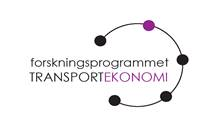No 2021:1: Long-distance mode choice model estimation using mobile phone network data
Angelica Andersson (), Leonid Engelson (), Maria Börjesson (), Andrew Daly and Ida Kristoffersson ()
Additional contact information
Angelica Andersson: Research Programme in Transport Economics, Postal: Forskningsprogrammet TRANSPORTEKONOMI, Att: VTI, Box 55685, 102 15 STOCKHOLM
Leonid Engelson: Research Programme in Transport Economics, Postal: Forskningsprogrammet TRANSPORTEKONOMI, Att: VTI, Box 55685, 102 15 STOCKHOLM
Maria Börjesson: Research Programme in Transport Economics, Postal: Forskningsprogrammet TRANSPORTEKONOMI, Att: VTI, Box 55685, 102 15 STOCKHOLM
Andrew Daly: Research Programme in Transport Economics, Postal: Forskningsprogrammet TRANSPORTEKONOMI, Att: VTI, Box 55685, 102 15 STOCKHOLM
Ida Kristoffersson: Research Programme in Transport Economics, Postal: Forskningsprogrammet TRANSPORTEKONOMI, Att: VTI, Box 55685, 102 15 STOCKHOLM
Abstract: In this paper we develop two methods for the use of mobile phone data to support the estimation of long-distance mode choice models. Both methods are based on logit formulations in which we define likelihood functions and use maximum likelihood estimation. Mobile phone data consists of information about a sequence of antennae that have detected each phone, so the mode choice is not actually observed. In the first trip-based method, the mode of each trip is inferred by a separate procedure, and the estimation process is then straightforward. However, since it is usually not possible to determine the mode choice with certainty, this method might give biased results. In our second antenna-based method we therefore base the likelihood function on the sequences of antennae that have detected the phones. The estimation aims at finding a parameter vector in the mode choice model that would explain the observed sequences best. The main challenge with the antenna-based method is the need for detailed resolution of the available data, i.e., that the mobile phone operator might not be willing or able to provide the modeller with sequences of antennae that have detected the phones. In this paper we show the derivation of the two methods, that they coincide in case of certainty about the chosen mode and discuss the validity of assumptions and their advantages and disadvantages. Furthermore, we apply the first trip-based method to empirical data and compare the results of two different ways of implementing it.
Keywords: Demand model; Mode choice; Mobile phone network data; Travel behaviour; Long-distance travel
18 pages, June 16, 2021
Full text files
WP-2021-1.pdfFull text
Questions (including download problems) about the papers in this series should be directed to Mats Berggren ()
Report other problems with accessing this service to Sune Karlsson ().
RePEc:hhs:trnspr:2021_001This page generated on 2024-09-13 22:17:19.

